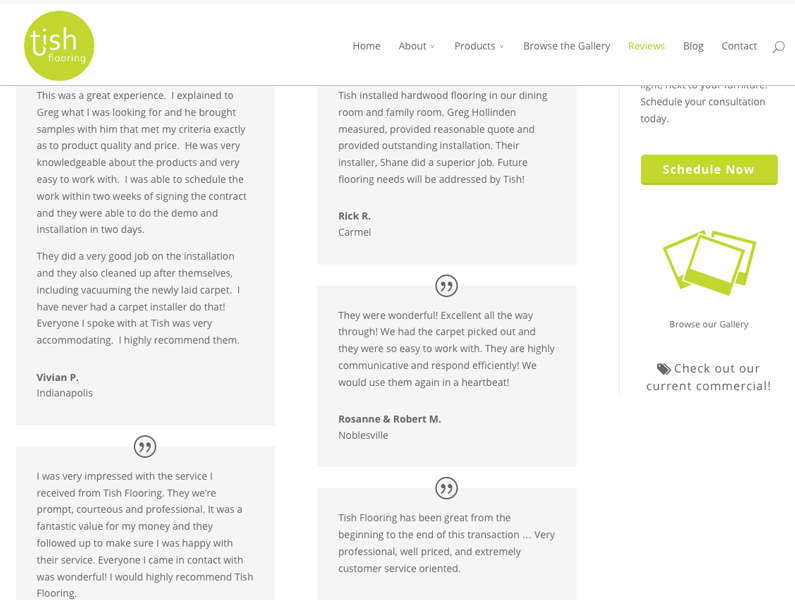How to Make a Perfect Second Impression
You know first impressions are everything. That first eye contact, handshake, “nice to meet you.” Online, that might be your Tweet, Retweeted by a connection. If you’re not the Tweetin’ kind, maybe the action’s on LinkedIn, Houzz, or Facebook.
What happens in the second impression? Research. The second impression’s almost always online, checking to see if you’re authentic and experienced. Checking to see if you’re worth caring about.
Stand out in the second impression by making research easy. Use your website and published content to authenticate your success and experience, starting with the stories clients tell about you.
Share Testimonials
The best business relationships start as referrals. Someone’s looking for something, talks to their friend who tells them about you and how completely awesome you are, then you get a call from a warm, pre-qualified lead.
Testimonials are stories from clients past and present that prove you know your stuff and what you make or do really works. Review sites all over the internet hold a treasure trove of these stories. Hopefully, they’re all good things. But you can’t moderate your reviews on these platforms to remove the poor reviews.
You can control what you put on your own website. Make good use of your own platform to showcase the best stories.
There are two approaches to website testimonials: collect eight to ten short statements on one page or write three to four case studies that show the problem, your solution, and the results. If you have reviews on a platform like Yelp or Houzz, display those with one of their widgets.
See how Tish Flooring shows their reviews? Each one is just a few sentences, but each says something unique. Avoid compliments like “great job” that don’t make sense without context. This page has a lot of elements, but the approach is still quality over quantity.
Take this further by publishing a case study. Like a testimonial page, a case study shows prospective customers you’re experienced and proven. However, it’s written from your perspective and fuses results data with visuals and testimonial content. Start with a description of the challenge, show your proposed solution and the finalized action. End with the tangible results and if possible, a statement from the client. Look at Roundpeg’s Home to Indy case study for an example.
Display Your Portfolio
As customers research possible vendors, they’re constantly looking for work samples. Roundpeg’s web design work samples are a popular destination on our site. If your business is highly visual, plan to document the finished product. If you can, grab before and afters for a case study.
To start building your portfolio, think about the projects you’re the most proud of. These projects should represent the best of what you can do. You should be able to tell a story about each of them if someone asks. Like testimonials, select a variety of projects that show the breadth of your expertise. Use your portfolio to show how wide you can work. If you do a lot of work for a specific niche, make a section dedicated to your work serving that group.
Portfolios should be easy to scan. Try a grid of thumbnail photographs for visual industries. If you’re a writer, include images with your clip file if you can. Or try a bold, text-only design that shows off your writing.
Introduce Your Staff
Who are you? If there’s one thing that can seal the deal during online research, it’s your smiling face and story. Unfortunately, most “About Us” pages read like a sentimental textbook. Instead of reminiscing or ego-stroking, show your face. Show what you believe in, what your company is about. And do it in under 200 words. Use one expressive image to illustrate your statement.

Shinola tells their story with an introduction that sets the vision and a body that shows the faces of their most prominent staff. I highly recommend a gallery of staff portraits for service businesses and craft-focused companies. Show me what to expect with a well-written vision statement and solid team pictures.
This might be a tall order, depending on your resources. It might take brainstorming, a professional copywriter, a professional photographer, and some updates to your web design. But you’ll be happier with professional results and customers will be happy to put a face to the name on your business card.
Blog To Be Helpful
Real people, potential customers all, search for information at all hours of the day and night. They’re looking for someone to tell them what to buy and who to buy from. They’re looking to make first impressions. When your site solves their problem, you look good, period.
Blogging has its SEO benefits, you can go for hours on that topic. More important, blogging benefits your customers. It builds their trust in you between those in-person meetings, purchases and service appointments.
When you meet someone new, follow up with an email. Share a link to something from your blog they might like. It’s low pressure, but keeps the conversation going.
Have you paid attention to your second impression lately? There’s no substitute for going out and making connections. It takes real effort and drive to make that happen. But don’t forget about maintaining those connections. Supportive content on your website makes research easy, building trust long after the meeting’s over.
Listen for more on this topic.
got a project?
Whether you need a new website or some help with your social media we are ready to start the conversation.

A Handwritten Note Adds a Personal Touch
Use a handwritten note to add a personal touch to your business communication. Small businesses will sell more when they make their prospects feel special.
Looking For Team ‘Peg? You’ll Find Us Here
In the early days of Roundpeg, Lorraine was an active networker, often dropping by 2 - 3 events a...
5 Types of Networkers: What Type are You?
Awkward, Alone, and Afraid If you are like me, you become nervous and anxious when attending a new...
Happy Anniversary Indy Friend Up
Nine years ago, my friend Randy invited a few friends to a meetup. While we were all connecting on...

